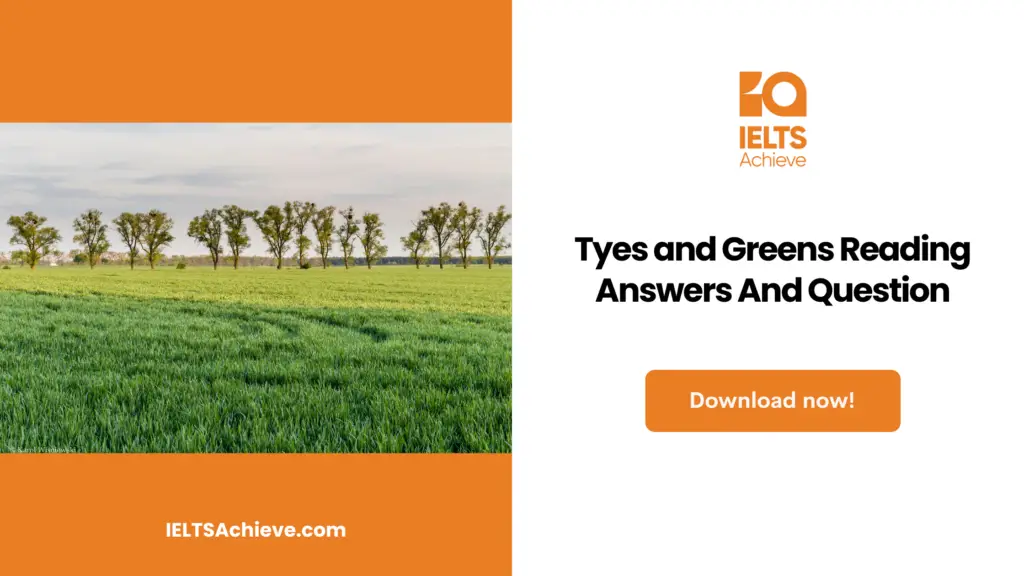The Blog post contains the following IELTS Reading Questions:
- IELTS Reading Multiple Choice Questions
- IELTS Reading Sentence Completion
- IELTS Reading Summary Completion
Stay informed and prepared for success – Explore our comprehensive Reading Test Info page to get valuable insights, exam format details, and expert tips for mastering the IELTS Reading section.
IELTS Reading Passage – Tyes and Greens

Tyes and Greens
In this area of East Anglia, there are several settlements with names that include the word “tye.” The Oxford English Dictionary asserts that the word’s earliest recorded use goes back to 832 and that the term’s origin is Anglo-Saxon. A “tye” was a green space or a small patch of inhabited public land, typically located away from the main city or community, maybe at the intersection of two or more roads. The tye was available for locals and passing tourists to graze their horses, pigs, and other farm animals.
It appears that there were five or six of such tyes in the Pebmarsh region, all except one located on the parish’s outskirts. These marginal clearings are all found far from the richer farming area along the river and, in the cases of Cooks Green, Haylcs Tye, and Dorking Tye, near the edge of still-existing pieces of old forest. It is probable that, elsewhere in East Anglia, ancient freemen were authorized to clear a small section of the forest and establish a small farm. In any scenario, the rich aristocratic or monastic landlords would not have been interested in buying such unproductive forest terrain. Earls Colne Priory, a rich monastery located approximately 10 kilometers to the south, acquired most of the land in the vicinity around Pebmarsh Village. It’s possible that during the 13th and 14th centuries, tenant farmers who paid rent to the Priory were responsible for maintaining the tyes.
Hayles Tye appears to have derived its name from a certain John Hayle, who was documented in the 1380s, though there are documents indicating the site’s occupation is far older. The word was still used in 1500, and it reappears frequently in the 16th and 17th centuries, generally in association with the payment of taxes or tithes. The name was switched to File’s Green sometime during the 18th century, even though no indication of an owner named File has been discovered. The original houses that existed at the location vanished at the same time in the 18th century. This land and its houses may have simply been abandoned during this time because a large portion of this region faced economic depression. The population of the neighboring village of Alphamstone was considerably reduced due to the desertion of several farms, leaving insufficient money to maintain the fabric of the church, which rapidly deteriorated. However, it is also possible that the File’s Green dwellings were destroyed by fire, as fires were very unusual at the time.
Charles Townsend of Ferriers Farm owned the land by 1817, and in 1821 he constructed two brick cottages there, each of which was inhabited by two families of farm laborers. These cottages had a relatively simple design, with a two-story rectangular structure that was separated in the middle by a large communal chimneypiece. Each house had a fireplace; however, the two families seemed to have shared a brick broad oven that bulged out from the back of the cottage. The exterior wall of the bread oven may still be visible on the remaining cottage. The chimney design and the fireplaces themselves seem to be older than those of the 1821 cottages and could have been from earlier residences. The common land had long since vanished, and the two cottages remained on a small plot of land that is barely an acre, on which the laborers could yield a few vegetables and raise a few chickens or a pig. They spent most of their time working on Ferrier’s farm.
On maps from 1874, both cottages are visible, but by the end of the century, one of the two had vanished. Again, the latter quarter of the 19th century was a time of agricultural depression, and many smaller farms in the vicinity were deserted. There are remnants of Mosse’s Farm, which is still partially surrounded by a highly overgrown moat and is less than a kilometer from File’s Green. One of the houses was probably abandoned, allowed to deteriorate, and then dismantled when the demand for agricultural labor was reduced. In the garden of the remaining cottage, stray pieces of debris and brick could still be found.
This house was sold in 1933 to the manager of the recently founded gravel works towards the northwest of Pebmarsh village. These two dwellings were merged by him. Therefore, File’s Green Cottage is the only house that remains on the site.
Unlock your full potential in the IELTS Reading section – Visit our IELTS Reading Practice Question Answer page now!
Recommended Questions:
Renewable Energy IELTS Reading Question with Answer
Tyes and Greens IELTS Reading Questions
Questions 1 – 4
Choose the appropriate letters A – D. Write them in boxes 1 – 4 on your answer sheet.
1. In the Pebmarsh region, the tyes were ….
- used by the freemen of the medieval period.
- Haris Colne Priory’s property
- nearby a river
- mostly on the periphery of the parish
2. tye was ….
- an open communal land with trees
- a green
- situated at the intersections of two or more paths
- a huge open region
3. As per the author’s perspective, the rich landlords ….
- were lured to the beauty of the forest
- the views of forest lands did not appeal to them
- viewed forest land as useless
- felt the sight of a forest appealing
4. The Pebmarsh region ….
- most likely had six tyes.
- was not in the East Anglia region
- had approximately seven tyes
- seemed to have around 5 – 6 tyes
Ready to improve your performance in Multiple Choice Questions (MCQs)? Click here to access our comprehensive guide on how to tackle MCQs effectively in the IELTS Reading section.
Questions 5 – 9
Complete the sentences below with words taken from the Reading Passage. Write your answers in boxes 5 – 9 on your answer sheet. Use NO MORE THAN TWO WORDS for each answer.
5. Hayles Tye’s name was derived from ________, who is documented in the 1380s.
6. In the 18th century, the land was abandoned due to ______ depression.
7. In the year 1817, the tye was owned by __________.
8. Charles built two brick ______ on the site.
9. Less than a kilometer from the File’s Green, the ruins of _________ are found.
Enhance your sentence completion skills in the IELTS Reading section. Click here to access our comprehensive guide and learn effective strategies for filling in missing words or phrases in sentences.
Questions 10 – 15
Complete the text below, which is a summary of the Reading Passage. Use NO MORE THAN THREE WORDS from the passage to fill each blank space. Write your answers in boxes 10 – 15 on your answer sheet.
- The 1500s – the land’s name Hayles Tye was still (10.)_______, and it
(11.)________ once again related to the payments of taxes in the next two centuries. - 18th century – the tye’s name was changed to (12.)________, the earlier houses had disappeared or
(13.)________. - 1933 – The cottage on the land was now known as File’s Green Cottage, it was purchased by a local
(14.)________ manager, and he converted the cottage into (15.)_________.
Boost your performance in Summary, Notes, Table, and Flowchart Completion tasks. Click here to explore our detailed guide and learn how to effectively complete summaries, notes, tables, and flowcharts in the IELTS Reading section.
Unlock your full potential in the IELTS Reading section – Visit our IELTS Reading Practice Question Answer page now!
Recommended Questions:
Renewable Energy IELTS Reading Question with Answer
Tyes and Greens Reading Answers
1. D
2. B
3. C
4. D
5. John Hayles
6. economic
7. Charles Townsend
8. cottages
9. Mosse’s Farm
10. in use
11. cropped up
12. File’s Green
13. brunt down/ abandoned
14. gravel works
15. one dwelling

We hope you found this post useful in helping you to study for the IELTS Test. If you have any questions please let us know in the comments below or on the Facebook page.
The best way to keep up to date with posts like this is to like us on Facebook, then follow us on Instagram and Pinterest. If you need help preparing for the IELTS Test, join the IELTS Achieve Academy and see how we can assist you to achieve your desired band score. We offer an essay correction service, mock exams and online courses.

